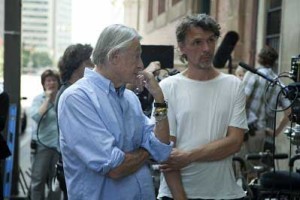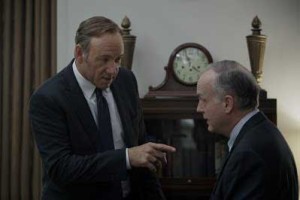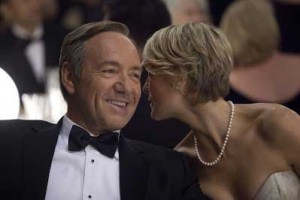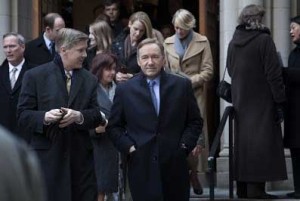
On top of a plush $100 million budget, the show boasts some of Hollywood’s top-tier talent, usually associated with their work in movies, not episodic series. David Fincher, nominated for the best director Oscar for The Curious Case of Benjamin Button and The Social Network, helmed the show’s first two episodes and supervised the remainder as executive producer. And Kevin Spacey, who first grabbed attention in The Usual Suspects, stars as Frank Underwood, the majority whip in the House of Representatives who is the ruthlessly Machiavellian protagonist and charming villain that audiences are inclined to root for.

The director of photography, with credits on films including In Bruges and Kinky Boots, (the basis of Cyndi Lauper’s smash Broadway musical) and on HBO’s You Don’t Know Jack feature, about the controversial suicide doctor – which earned Bryld a Primetime Emmy nomination – was pleasantly surprised when Fincher called and asked to meet him. The two hit it off. The referral most likely came from another House of Cards executive producer John Melfi, who had worked at HBO in the same capacity on Sex and the City and Rome and was familiar with his work on Jack.

Bryld was the cinematographer on the first two episodes, the ones that Fincher directed. The DP came back to lens several more shows later in the series, but the initial two were the most important because they served as templates for the show’s overall look. “When Fincher left, I had the task of coordinating with the directors and cinematographers that came later, and because I didn’t have a lot of prep time, it was a big challenge,” he said. “But it was a very important one in order to maintain the consistency of the show’s visual universe, while also allowing each individual director to do his thing.”
![Clockwise, from left, standing: executive producer Beau Willimon; unit production manager Don Hug; executive producer John Melfi; [seated] director Carl Franklin; and director of photography Eigil Bryld. (Photo by: Patrick Harbron for Netflix).](https://www.btlnews.com/wp-content/uploads/2013/05/LR-4-hoc_pds_037_h-300x200.jpg)
Bryld used two RED Epic digital cameras equipped with ARRI/Zeiss Master Prime lenses – a combo that allowed him to both shoot quickly and under low-light conditions, a specialty of the RED Epic. He hadn’t worked much with the camera before, but the company proved very helpful, doing custom programming. “The goal was to be able to shoot wide open and very fast,” he noted. “We didn’t want to be slaves of this digital technology. We wanted to fine tune it.” Lighting was kept simple, using point sources as much as possible. “We didn’t use big lights. The aim was to place one or two lights in a perfect position in order to let the cameras move as freely as possible.”
 Because of Fincher’s prohibitions against shooting handheld or with Steadicam, much of the camerawork was done on tracks by dolly grips. “In many ways they were the operators,” said Bryld. “Once a shot started, we’d fold our arms and the dolly grips would do all the work. It isn’t an easy job, because the camera has to be purposeful all the time and hit the mark.”
Because of Fincher’s prohibitions against shooting handheld or with Steadicam, much of the camerawork was done on tracks by dolly grips. “In many ways they were the operators,” said Bryld. “Once a shot started, we’d fold our arms and the dolly grips would do all the work. It isn’t an easy job, because the camera has to be purposeful all the time and hit the mark.”
Though House of Cards is set in Washington, it was by and large shot in nearby Baltimore with a few establishing shots in the nation’s capital, mainly of iconic buildings and monuments, along with a scene in the DC Metro. Not only is Washington extremely difficult as a location, shooting permits are maddeningly difficult to obtain and there are many restrictions. And Maryland also offered attractive tax credits as a lure.
In addition to location shooting in Baltimore where many buildings resemble those in Washington, much of the series was lensed on 150,000 square feet of sets built in a converted warehouse. These included the White House Oval Office, Congressional settings and Underwood’s home. Donald Graham Burt, Fincher’s favorite production designer who won an Oscar for best art direction for his work on Benjamin Button, applied his considerable skills to House of Cards.
Bryld has decided not to work on the second season of House of Cards. “I felt I had given it everything I had and it would be hard to add to that,” said the DP.
“I think I shot the Oval Office set 15 times,” he recalled. “I don’t want to shoot the Oval Office again until it is the real Oval Office.”





